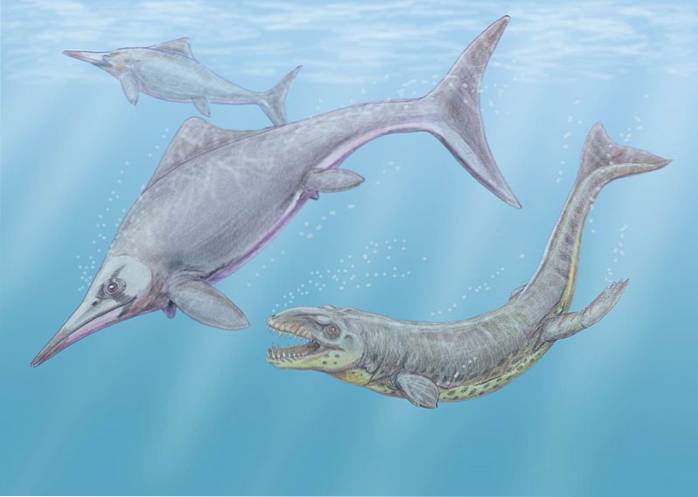
What is homoplasia? (With examples)
The homoplasia (from the Greek “homo", which means equal, and "plasis ", which means form; equal forms) is a characteristic shared by two or more species, but this characteristic is not present in their common ancestor. The basis for defining homoplasia is evolutionary independence.
Homoplasia between structures is the result of convergent evolution, parallelisms, or evolutionary reversals. The concept is contrasted with that of homology, where the characteristic or trait shared by the group of species was inherited from a common ancestor.

Article index
- 1 What is homoplasia?
- 2 Origin of the term
- 3 Types of homoplasia
- 4 Homoplasias: challenges before the reconstruction of evolutionary histories
- 5 Why do homoplasies exist?
- 6 Restructuring concepts: deep homologies
- 7 Mammals and Marsupials: A Radiation of Convergences
- 8 References
What is homoplasia?
In the branch of comparative anatomy, the similarities between the parts of organisms can be evaluated in terms of ancestry, function and appearance..
According to Kardong (2006), when two characters have a common origin, they are designated as homologous. If the resemblance is in terms of function, the two processes are said to be analogous. Finally, if the appearance of structures is similar, it is a homoplasia.
However, other authors give a broader meaning to the concept (overlapping with analogy), encompassing any similarity between two or more species that do not have a common origin. In this concept, the evolutionary independence of the event stands out.
Origin of the term
Historically, these three terms were used since pre-Darwinian times without any evolutionary meaning. After the arrival of Darwin and the exponential development of evolutionary theories, the terms acquired a new nuance and the similarity was interpreted in the light of evolution.
Homoplasia was a term coined by Lankester in 1870 to refer to the independent gain of similar characteristics in different lineages..
George Gaylord Simpson, for his part, proposed the distinction of similarities in analogy, mimicry and random similarities, although today they are considered as examples of convergences.
Types of homoplasia
Traditionally, homoplasia has been classified into convergent evolution, evolutionary parallels, and evolutionary reversals..
A review by Patterson (1988) seeks to clarify the use of the terms convergence and parallels, since they can often be confusing or misinterpreted. For some authors, the distinction is only arbitrary and they prefer to use the general term homoplasia.
Others suggest that, although the distinction between the terms is not very clear, they differ mainly in the relationship between the species involved. According to this view, when the lineages that present similar characteristics are distant, it is a convergence. In contrast, if the lineages are closely related it is a parallel.
A third type are reversals, where a characteristic has evolved and then, over time, returns to its initial or ancestral state. For example, dolphins and other cetaceans have evolved an optimal body for swimming that is reminiscent of the aquatic potential ancestor from which they evolved millions of years ago..
Reversals at the morphology level are often rare and difficult to identify. However, molecular evolutionary reversals - that is, at the level of genes - are very frequent..
Homoplasias: challenges before the reconstruction of evolutionary histories
When reconstructing the evolutionary histories of the different lineages, it is essential to know which characteristics are homologous and which are simple homoplasies..
If we evaluate the relationships between groups letting ourselves be guided by homoplasies, we will arrive at erroneous results.
For example, if we evaluate any mammal, whales and fish in terms of their modified fin-shaped limbs, we will conclude that fish and whales are more related to each other than both groups are to the mammal..
How we know the history of these groups a priori - we know that whales They are mammals - we can easily conclude that such a hypothetical phylogeny (close relationship between fish and whales) is a mistake.
However, when we evaluate groups whose relationships are not clear, homoplasies create inconveniences that are not so easy to elucidate..
Why do homoplasies exist?
So far we have understood that in nature "appearances can be deceiving". Not all organisms that are somewhat alike are related - in the same way that two people can look very much alike physically, but they are not related. Surprisingly, this phenomenon is very common in nature..
But why is it presented? In most cases, homoplasia arises as an adaptation to a similar environment. That is, both lineages are subject to similar selective pressures, leading to solving the "problem" in the same way..
Let's go back to the example of whales and fish. Although these lineages are markedly separate, they both face an aquatic life. Thus, natural selection favors spindle-shaped bodies with fins that move efficiently within bodies of water..
Restructuring concepts: deep homologies
Every advance in the development of biology translates into new knowledge for evolution - and molecular biology is no exception.
With the new sequencing techniques, an immense number of genes and their associated products have been identified. In addition, evolutionary developmental biology has also contributed to the modernization of these concepts..
In 1977, Sean Carroll and collaborators developed the concept of deep homology, defined as the condition where the growth and development of a structure in different lineages have the same genetic mechanism, which they inherited from a common ancestor..
Take the example of the eyes in invertebrates and vertebrates. The eyes are complex photoreceptors that we find in different animal groups. However, it is clear that the common ancestor of these animals did not possess a complex eye. Let's think about our eyes and those of a cephalopod: they are radically different.
Despite the differences, the eyes share a deep ancestry, since opsins evolved from an ancestral opsin and the development of all eyes is controlled by the same gene: Pax 6.
So are the eyes homologous or convergent? The answer is both, it depends on the level at which you assess the situation.
Mammals and Marsupials: A Radiation of Convergences
Examples of homoplasias abound in nature. One of the most interesting is the convergence between American placental mammals and Australian marsupials - two lineages that diverged more than 130 million years ago..
In both environments we find very similar shapes. Each mammal seems to have its "equivalent", in terms of morphology and ecology in Australia. That is, the niche that a mammal occupies in America, in Australia it is occupied by a similar marsupial.
The mole in America corresponds to the Australian marsupial mole, the anteater to the numbat (Myrmecobius fasciatus), the mouse to the marsupial mouse (family Dasyuridae), the lemur to the cucus (Phalanger maculatus), the wolf to the Tasmanian wolf, among others.
References
- Doolittle, R. F. (1994). Convergent evolution: the need to be explicit. Trends in biochemical sciences, 19(1), 15-18.
- Greenberg, G., & Haraway, M. M. (1998). Comparative psychology: A handbook. Routledge.
- Kardong, K. V. (2006). Vertebrates: comparative anatomy, function, evolution. McGraw-Hill.
- Kliman, R. M. (2016). Encyclopedia of Evolutionary Biology. Academic Press.
- Losos, J. B. (2013). The Princeton guide to evolution. Princeton University Press.
- McGhee, G. R. (2011). Convergent evolution: limited forms most beautiful. MIT Press.
- Rice, S. A. (2009). Encyclopedia of evolution. Infobase Publishing.
- Sanderson, M. J., & Hufford, L. (Eds.). (nineteen ninety six). Homoplasy: the recurrence of similarity in evolution. Elsevier.
- Starr, C., Evers, C., & Starr, L. (2010). Biology: concepts and applications without physiology. Cengage Learning.
- Stayton C. T. (2015). What does convergent evolution mean? The interpretation of convergence and its implications in the search for limits to evolution. Interface focus, 5(6), 20150039.
- Tobin, A. J., & Dusheck, J. (2005). Asking about life. Cengage Learning.
- Wake, D. B., Wake, M. H., & Specht, C. D. (2011). Homoplasy: from detecting pattern to determining process and mechanism of evolution. science, 331(6020), 1032-1035.
- Zimmer, C., Emlen, D. J., & Perkins, A. E. (2013). Evolution: Making sense of life. CO: Roberts.



Yet No Comments